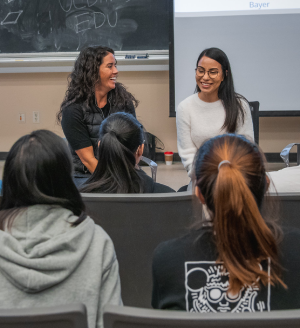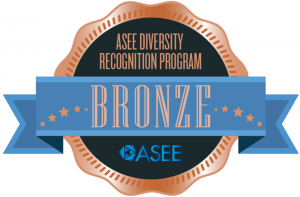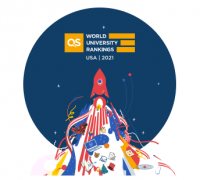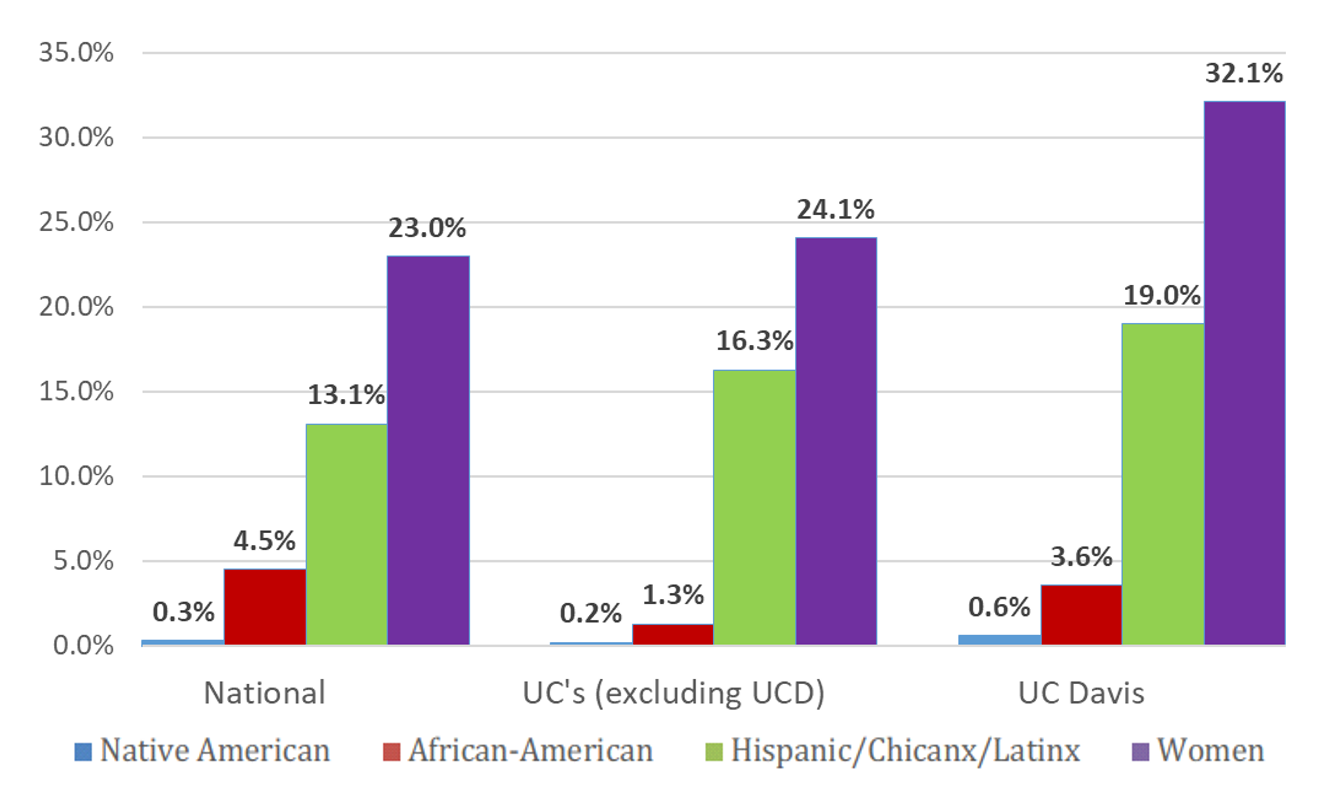
As many engineers know, diversity fosters engineering innovation and excellence, resulting in new solutions and positive societal impact. At the UC Davis College of Engineering, we’ve invested in specific efforts to increase the participation of women and underrepresented minorities in engineering and help them flourish.
In 2023, the college was again honored with a Bronze Level recognition as part of the American Society of Engineering Education’s Diversity Recognition Program. The ASEE Diversity Recognition Program was created to “publicly recognize those engineering and engineering technology colleges that make significant, measurable progress in increasing the diversity, inclusion and degree attainment outcomes of their programs.”

In our college, we strive to create an environment that is welcoming to and supportive of women and underrepresented minorities, coupled with an unwavering dedication to student success and diversity that sets us apart from other, large public institutions of higher education.
The College of Engineering has undertaken a wide range of efforts to address implicit and explicit bias, racism and structural inequalities present within our community. We encourage you to learn more about our plan below, learn about how our campus is making strategic investments in diversity, equity and inclusion and hear our students, staff, faculty voices and experiences through our Engineering an Inclusive Future platform.
UC Davis Takes Top Spot for Diversity in National Rankings

The University of California, Davis, has taken top spot among universities in the nation for its inclusiveness, diversity and internationalization in the 2021 QS USA University Rankings.
Diversity and Inclusion Plan
The following definitions are used regarding diversity, equity and inclusion:
Diversity: For the purpose of our plan, as it relates to recruitment, retention, and degree completion from the College of Engineering (the college), diverse populations will be defined as women and underrepresented minorities (underrepresented minorities in STEM = African Americans, American Indians/Alaska Natives, and Chicanx/Latinx).
Equity: We define equity as a process that begins by acknowledging the advantages and barriers that keep us from all starting at the same place and continues through actions to correct and address the imbalance.
Inclusion: Active effort to create a welcoming environment and sense of belonging for all students regardless of race, ethnicity, gender, age, religion, language, abilities/disabilities, sexual orientation, gender identity, socioeconomic status, geographic region as prescribed by University of California (UC) policy.
The following university statements informed this plan:
The UC Davis Office of Diversity, Equity and Inclusion cites two value statements: the UC Diversity Statement and the campus’s Principles of Community. These are guideposts for a common vision of diversity and inclusiveness at UC Davis.
With the Diversity Statement and Principles of Community as guides, UC Davis has defined a set of goals, objectives and recommended action items that provide a framework to achieve our diversity and inclusion goals. This strategic plan also describes activities that can help the campus make clear and deliberate progress toward inclusion excellence. The strategic plan also suggests appropriate metrics for measuring the achievement of short- and long-term goals.
Consistent with these statements, the college is committed to achieving greater diversity, equity and inclusion in engineering, realizing that inclusive, diverse professions are more capable of creating long-term, relevant answers to societal problems and building a world that works for all of us.
Current State
The most current census data for California shows that underrepresented groups (URGs) make up 48.4% of the population with Hispanics accounting for 40.2%; Black/African American 6.5%; American Indian and Alaska Native 1.7%; and women make up 50.0% of the population (US Census, July 2021).
Below, we show engineering bachelor’s degrees awarded by the UC Davis College of Engineering, compared to engineering bachelor’s degrees awarded Nationwide and engineering bachelor’s degrees awarded at remaining University of California Engineering Programs excluding UC Davis (ASEE 2020 Data).

These data show that UC Davis awards 9% (1.4 fold) more BS degrees in engineering to women than all engineering programs nationwide. The fraction of engineering BS degrees awarded to women at UC Davis is also 8% (1.33 fold) greater than other UCs who serve identical demographic populations. The fraction of engineering BS degrees awarded to URG students at UC Davis is 5% (1.3 fold) higher than both the national average and the average across engineering programs at our sister UCs. As described below, over the next four years we are committed to increasing the fraction of URG and women undergraduate students within the college to 30% and 40%, respectively.
Hispanic students are the largest URG in the College of Engineering. The fraction of engineering BS degrees awarded to Hispanic students at UC Davis is 6% greater than engineering programs nationwide and 3% greater than engineering programs at other UCs. UC Davis is now classified as an Emerging Hispanic Serving Institution.
Currently, 23% of faculty in the college are women, 4% (1.2 fold) greater than the national average. The UC Davis College of Engineering currently ranks 10th in the nation for the percentage of women on faculty among the U.S. News and World Report’s top 50 ranked engineering programs (ASEE data, 2021). As described below, we are working on increasing the percentage of women on our faculty to 30%, within the next four years. This would position us as first among R1 university engineering programs for the percentage of women on our college faculty.
Future Goals
Our DEI plan envisions a College of Engineering that more accurately reflects the diversity of California and the nation. The college has recently established highly successful ‘in house’ programs to recruit, admit, and retain populations reflective of California’s diverse demographics. These programs include AvenueE which provides a smooth transition from community college to the UC Davis College of Engineering, and LEADR which recruits, retains and graduates a diverse population of first-generation and historically-underserved engineering students. The college has also established dedicated infrastructure to promote DEI values college-wide, including a faculty and staff DEI committee which was awarded a 2022 Citation of Excellence by UC Davis. The dean of the college has also appointed a faculty advisor on diversity and inclusion, who serves on the college’s leadership team.
Though the number of women and URGs in graduate programs in the College of Engineering have increased markedly over the past decade, and continue to grow, we have redoubled our efforts to broaden participation at the graduate level through new partnerships with minority-serving California State University campuses, as well as providing undergraduate research experiences for students from communities historically marginalized in STEM. The college will continue its efforts to increase the number of women and underrepresented minorities in our student body and faculty, engage in outreach activities to promote the unlimited potential of STEM careers, and focus our educational programs to prepare our graduates for careers in a quickly changing, diverse global economy. Our future goals are organized around the following objectives.
Increase and support a diverse engineering faculty
To increase the diversity of the faculty, the college is engaging in targeted recruitment of new, diverse faculty and is also participating in campus-wide efforts to reduce implicit bias, develop an environment within which to share and discuss experiences and ideas, and create a sense of community through faculty mentoring and cohorts. We also plan to increase the percentage of women faculty in the college to 30% within the next four years, thereby positioning the college as first among R1 universities in the nation for the percentage of women faculty. We strongly believe that diversity within our faculty will also serve to attract and retain underserved undergraduate and graduate populations in the college.
Recruit and admit populations reflective of California’s diverse demographics
Through critical reevaluation of current recruitment programs, increased collaboration with two-year and four-year institutions, and partnerships with K-12 schools and programs, the college will work independently and in close collaboration with the UC Davis offices for undergraduate and graduate admissions and other campus centers and programs to recruit and admit a student population that more closely mirrors the demographic diversity of the state. By leveraging ongoing programs such as LEADR and AvenueE, which focus on increasing the participation of underrepresented students in engineering and computer science, we plan to increase the fraction of URG undergraduate students within the college from 23.2% to 30% over the next four years. Similarly, over the next four years we have a goal of increasing the percentage of women undergraduate students within the college from 32.1% to 40%. The consistent, annual increase in the number of students participating in LEADR and AvenueE, make these goals feasible.
Retain, from matriculation to degree completion, populations reflective of California’s diverse demographics
To improve retention and degree completion rates, the college will examine existing retention programs, seeking to identify the possible barriers and challenges that affect student transitions and student academic success. In close collaboration with campus retention programs and services, the college will connect students to resources, provide opportunities for mentoring, and assist students with navigating the complexities of their degrees. The college will continue to organize events to inspire and retain students who are women or who are from historically marginalized communities in STEM. These events, which are organized around AvenueE and LEADR, include competitions (such as the recently organized Corsi-Rosenthal filtration-box competition) and excursions to industrial facilities.
Establish dedicated college infrastructure related to diversity, equity and inclusion
As part of creating an inclusive culture for all faculty, staff and students, the college will develop additional infrastructure to support such an environment. This includes the establishment of an overarching strategic community vision, investments in our existing and award-winning faculty/staff DEI committee, support for student-led efforts in identity-specific organizations, renovation of college spaces to enhance inclusiveness, and infusion of courses with discussions of technology for the greater good and issues of engineering and social justice. The college also plans to develop and increase services to support members of the community, facilitate constructive and crucial conversations, and allocate space and resources.
Increase knowledge and understanding of issues of diversity, equity, and inclusion
Inherent in the priorities of the college is a need to increase faculty, staff and student knowledge and understanding of DEI issues. Towards that aim, the college’s DEI committee is organizing and promoting trainings in areas such as, but not limited to: cultural humility, implicit bias, stereotype threat, being an ally, mental health, universal design, and micro-aggressions. The college will also determine opportunities to recognize DEI efforts undertaken by faculty, staff and students at the department, unit and individual levels. Increasing communication about such efforts will not only increase the visibility of the college’s efforts, but also reinforce a culture that advocates and supports diversity, equity and inclusion within the college and beyond.
Improve accessibility for all
Through critical reevaluation of the current facilities and websites, as well as policies and practices, the college will identify opportunities to improve accessibility for all of its faculty, staff and students. Once identified, the college will implement changes in support of improved accessibility.

